Musicarta Modes - Mediant Substitution
Mediant Substitution (Part 2)
Mediant substitution is a simple but powerful technique for making all your chord sequences sound more sophisticated. This Module applies the mediant substitution technique to the three riffs in Module Five.
Download up-to-date MIDI files for this page.
Here are the three modal minor i-ëVII riffs from Module Five. The left hand column gives the original version. The right-hand column showcases the same three riffs treated with mediant substitution.
Riff One: Original
With mediant substitution
Riff Two: Original
With mediant substitution
Riff Three: Original
With mediant substitution
In this module, you practice the mediant substitution process and experiment with the new sounds you can create from simple two-chord material.
The first riff
Here is the first riff in the table above, original and treated.
Original
With mediant substitution
Revise the original riff. Here are the right hand i-ëVII inversions used and the chord sequence.
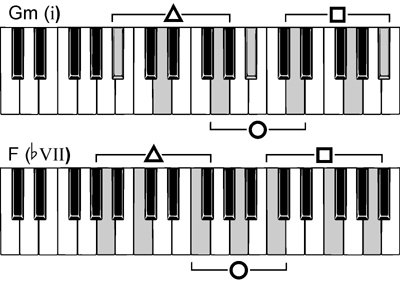

Making the mediant substitution chords
This is how to make the mediant substitute seventh chord for the G minor chords.
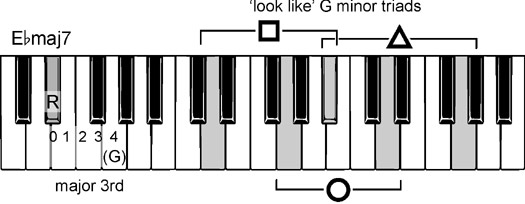
You lower the root of the G minor chords a major third (two whole tones, four semitones) to create E flat major seventh chords.
This is how to make the mediant substitute seventh chord for the F chords.
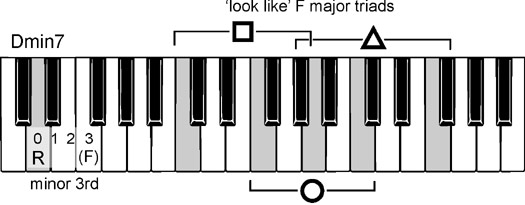
You lower the root of the F chords a minor third (three semitones) to create D minor seventh chords.
The mediant substitution chord sequences
Here is the chord sequence of the riff treated with mediant substitution, shown as slash chords. (There is no change in the first line.)

However, it is not usual to write seventh chords as slash chords. (This is a Musicarta technique for looking at and learning them.) Here is the chord sequence written out using conventional chord symbols.

Note that we cannot use the circle/square/triangle method to indicate seventh chord inversions.
Use the keyboard diagrams and the chord sequence charts to play the mediant substitution version of the first riff.
The second riff
Riff Two: Original
With mediant substitution
Here are the original and treated versions of the second Module Five riff.
The second riff uses chords E minor and D major. Revise the original riff.
Here is the original riff chord sequence.

Here are the mediant substitution chords for E minor and D.
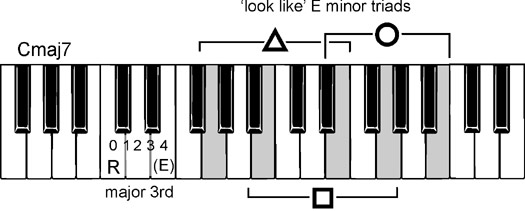
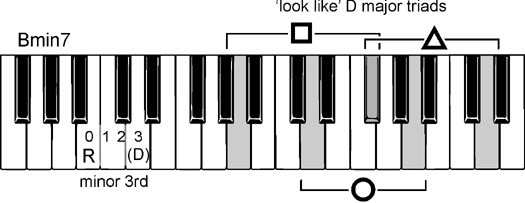
Three possible mediant substitution variations
You, the improviser/composer, choose when and where to use mediant substitution to vary your chord sequences.
Here are three possible mediant substitute versions of the second Module Five riff.
Here is a version with substitutions in the second half of the line.

You might introduce substitutions earlier in the line and climb back out at the end:

The extreme is to have substitution all the way through.

The last chord has been left as D major, but notice how the sequence still wants to cadence into E minor – the mode has got into your head!
Play and listen to the three versions. Think about why and when one version might be preferable to the others. Make your own variation and write it down. You can use slash chords for notation if you prefer.
Errata. Last line of above audio is Em / Bm7 repeating.
The third riff
The third Module riff 5 uses D minor and C major chords. Here are the original and mediant substitution versions.
Riff Three: Original
With mediant substitution
Revise the original riff.
Here are the keyboards showing the D minor and C mediant substitution chords you will be using.
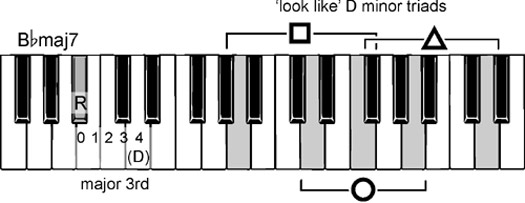
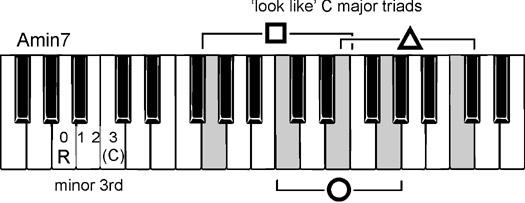
The original chord sequence is:

A chord sequence using all the possible mediant substitutions would be:

Listen to the audio of a treated version. Try to hear what substitutions have been made. Make a note – any shorthand will do – and play what you have written down.
|
OUT NOW! |
THE MUSICARTA BEAT & RHYTHM WORKBOOK At last! An effective approach to keyboard rhythm & syncopation skills. Learn more! |
ONLY $24.95! |
MODES |
The MusicartaA methodical approach to keyboard syncopation for
|
PUBLICATIONS
exciting keyboard
creativity courses
CHORDS 101
WORKBOOK

~HANON~
video course

Musicarta
Patreon
PENTATONICS
WORKBOOK
video course

Creative Keyboard
video course

BEAT AND RHYTHM
WORKBOOK

- Volume 1 -

12-BAR PIANO
STYLES WORKBOOK

MUSICARTA MODES
WORKBOOK

PIANO STYLE

CANON PROJECT
video course

VARIATIONS
video course


- Piano Solo -
video course

- Piano Solo -


YouTube playlists





 THE LOGO
THE LOGO
